1. Introduction: The universal language of healing music

Some wounds are not visible in scans. They resonate in the silence of sleepless
nights, the quiet ache of being overwhelmed, and the racing thoughts that offer no
respite. But the breach where words fall short is reached through a different language
— music.
Throughout history and across cultures, music has served a higher purpose than
art; it has offered therapy. Be it the Raga Darbari’s haunting depths or the soft
whispers of a Native American flute, sound can accomplish what medication fails to
do — comfort the heart.
This blog will focus on the specifics of music therapy, and uncover the mental health
issues it aids, understand the power of certain Indian ragas and global compositions
wield toward emotional restoration, and learn how to integrate them into daily life
practices.
This is more than just music. It’s about pursuing the balance we all need when life feels
dissonant.
2. The powerful benefits of music therapy
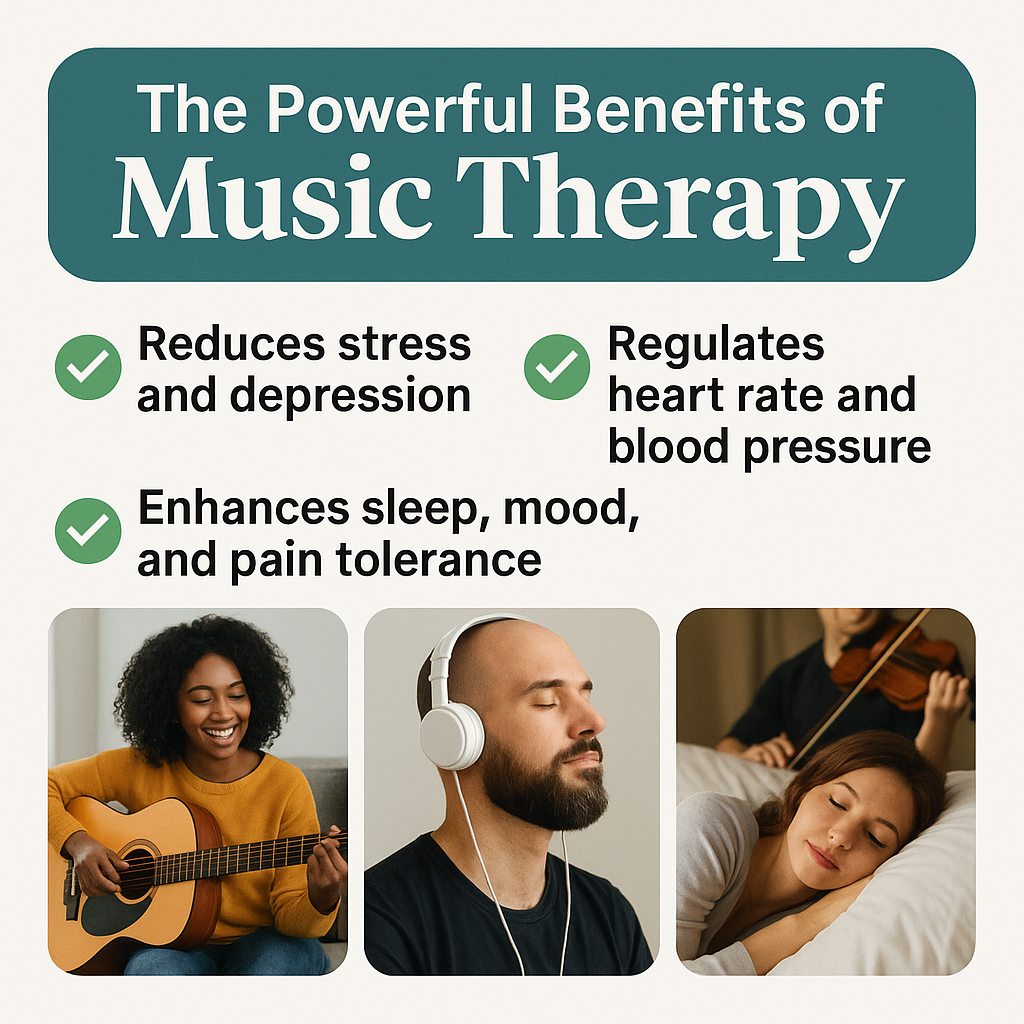
Musical works do not interrogate; instead, they listen. Subsequently, Healing Harmonies
commences.
If practiced with intention, music therapy alleviates anxiety, depression, and
even bodily pain. Healing Harmonies through music slows the heart rate, decreases
blood pressure and cortisol levels, and calms the sympathetic nervous
system.
Insomnia, grief, debilitating fatigue, trauma… these become far less daunting
with music. Music helps even children stay focused with ADHD, enables
emotional expression with autism, and provides solace for cancer patients
enduring incredible stress.
Music as therapy is not mere background noise. It is the thoughtful
treatment for the mind wrapped in beautiful melodies.
3. How music therapy actually works- the process explained (new section)

Music therapy is not simply listening to music with your eyes closed. It is an
orchestrated process to be followed by qualified therapists trained in both music
and psychology.
In a unit session with an individual or group, the therapist will:
● 🎧 Prompt you to listen to music with a calming focus or mood-enhancing
effect
● 🥁 Release controlled emotions through instrumental expression
● ✍️ Write lyrics or compose songs that represent your experiences
● 🧘 Use music as a vehicle during mental imagery or breath regulation
Exercises to facilitate the transition between various cognitive states
With each tailored session, whether for anxiety, grief, trauma, or even pain, the
Focus is not on performance, but on connection, Release, and mood
restructuring.
The gradual perception of music as a safety net shifts the rhythm of Healing Harmonies,
quiet yet profound.
4. Who needs music therapy: the age group that benefits most
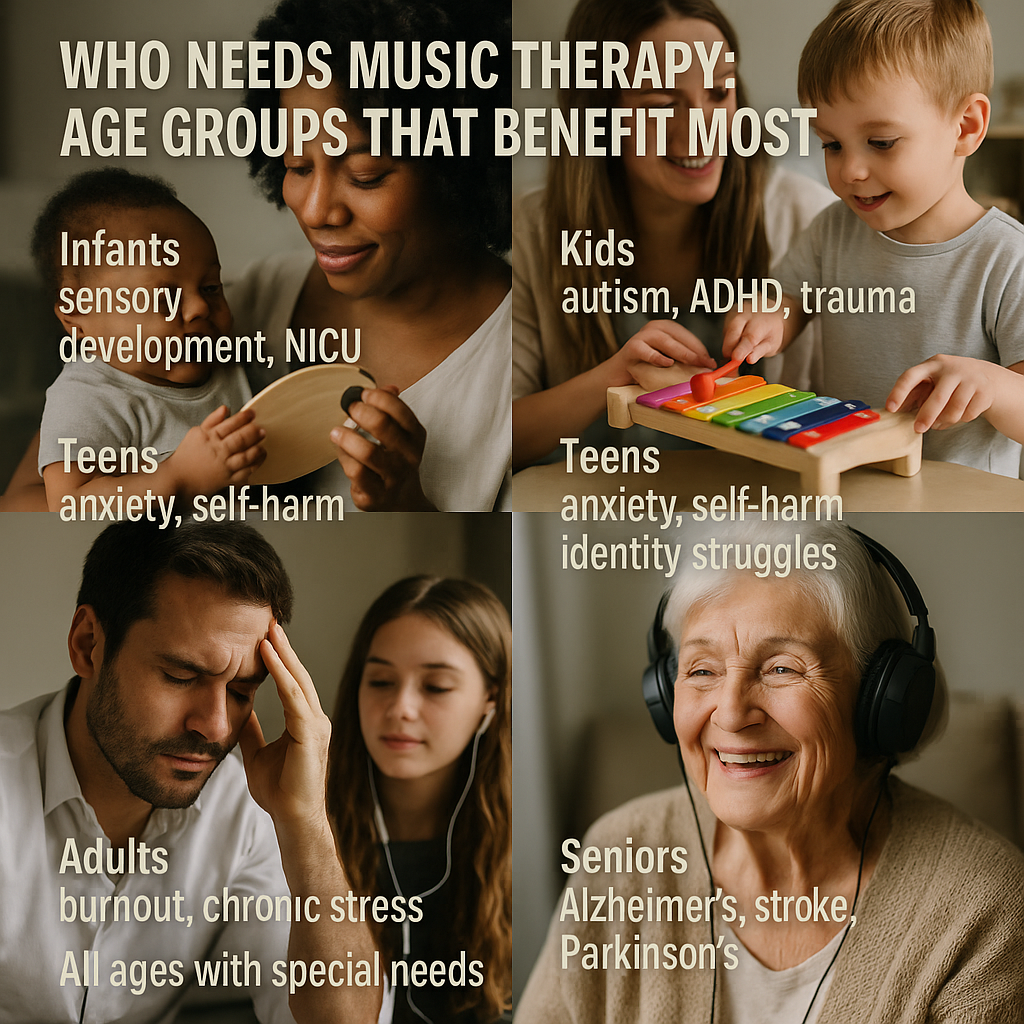
While musical healing can be beneficial for everyone, certain life stages may need it
more than others.
● 👶 Infants & Toddlers:
In NICUs, lullabies calm infants and toddlers while also controlling heart rate and
respiration. Rhythms are important for sensory development during the stage of
bonding with caregivers, and so is emotional bonding.
● 🧒 Children:
Autism, ADHD, and traumatic experiences render some children incapable of expressing
themselves. Music provides the means to articulate emotions that would otherwise
pose a challenge. It assists in boosting concentration, diminishing anxiety, and
processing emotions.
● Teenagers:
Teens engulfed in crippling amounts of academic pressure, identity crises, or
undiagnosed depression can find solace in music. While for some it acts as a diversion,
for others it becomes a release as well as a means of reflection.
● Adults:
Music is great for untangling one’s emotions and dissociating from overwhelming
feelings of burnout, grief, and heartbreak that form when one is subjected to a
monotonous life.
● 👵 Elderly:
Residing in elderly care homes with dementia, Parkinson’s disease, and feelings of
profound solitude leaves one with shattered emotions. Music acts as a savior by
elevating their spirits, rekindling precious memories, and restoring their self-esteem.
Music therapy isn’t just for the ailing; rather, it is for anyone yearning for wholeness.
5. Mental disorders, music therapy can help with
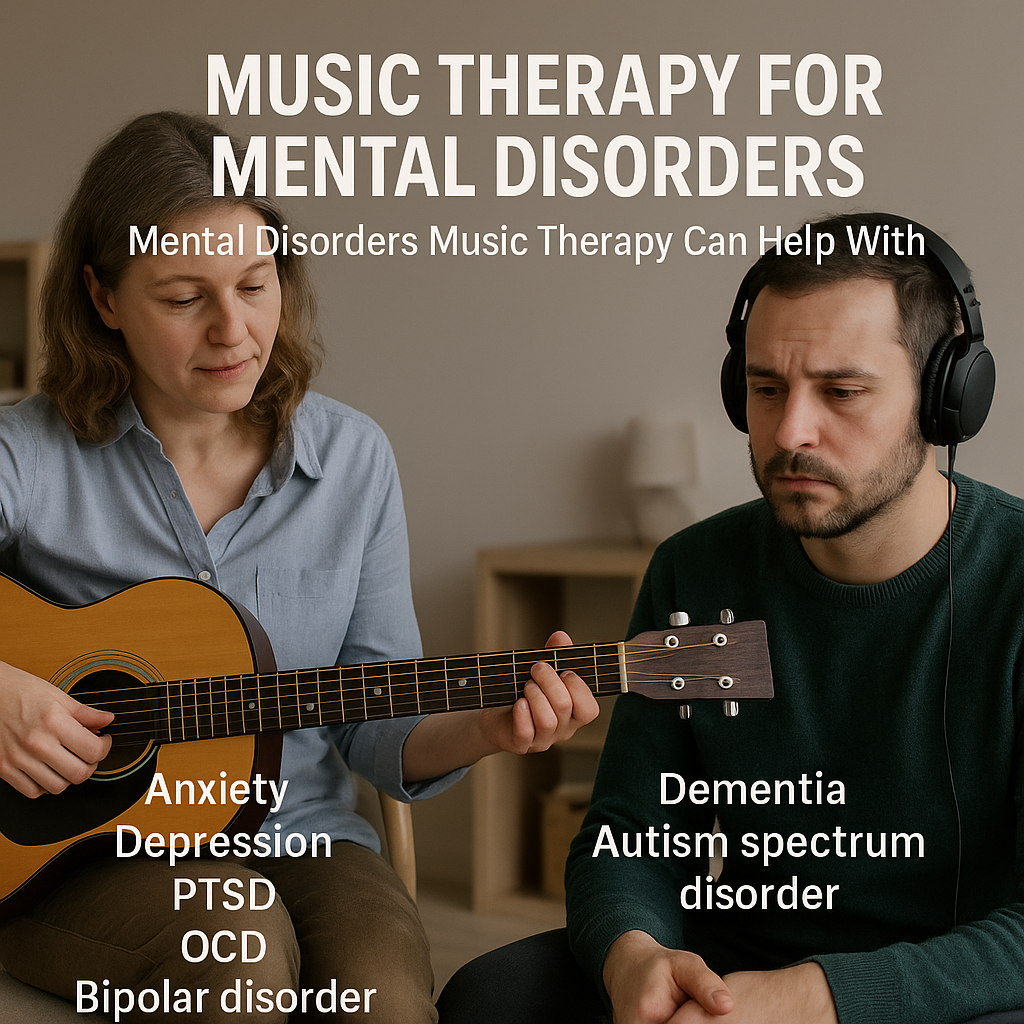
Some battles are invisible. But music contemplates the- and lightens their
burden.
● 🎭 Depression & Anxiety:
During difficult times in life, music can change one’s mood, ease sorrows, and
Heal when everything else fails.
● 🌪 PTSD & Trauma:
Music offers a refuge from overwhelming emotions, allowing one to feel and
Reconnect with the body at one’s own pace.
● 🧩 OCD & Bipolar Disorder:
Emotionally charged highs and lows are handled through rhythmic order that
stabilizes shifting and fluctuating feelings.
● 🧠 Schizophrenia:
Agitation can be lessened through music. Communication becomes easier, and
The connection with reality is improved.
● 🧩 Autism Spectrum Disorder:
With the help of expression, routine, and understanding of emotions through
melody, Schizophrenia is aided.
● 🧓 Dementia & Alzheimer’s:
When everything else fails, music comes through. It brings relaxation, helps
identify the surroundings, and restore happiness, even when one’s memory is
hardly there.
While music therapy cannot cure, it acts as a ddearcompanion during life’s
journey of recovery.
6. How music therapy transforms mental health

Music doesn’t just sound pleasing; it transforms the brain.
When emotionally engaging music is played, the brain releases dopamine, also
known as the pleasure chemical. It also lowers cortisol, which is the stress
hormone, and increases serotonin, which is good for mood and reduces anxiety.
Apart from these chemicals, music alters the state of one’s nervous system. It
decreases the heart rate, slows the breathing rate, and activates the vagus nerve,
which is responsible for signaling the body that it is safe.
For people who feel stuck in cycles of chronic fear, sadness, or numbness, music
serves as a pattern disruptor, guiding the individual toward emotional expression
and a state of relaxation.
This is not simply therapy. This is note by note, step by step, rewiring.
7. The Healing Harmonies: science of indian ragas
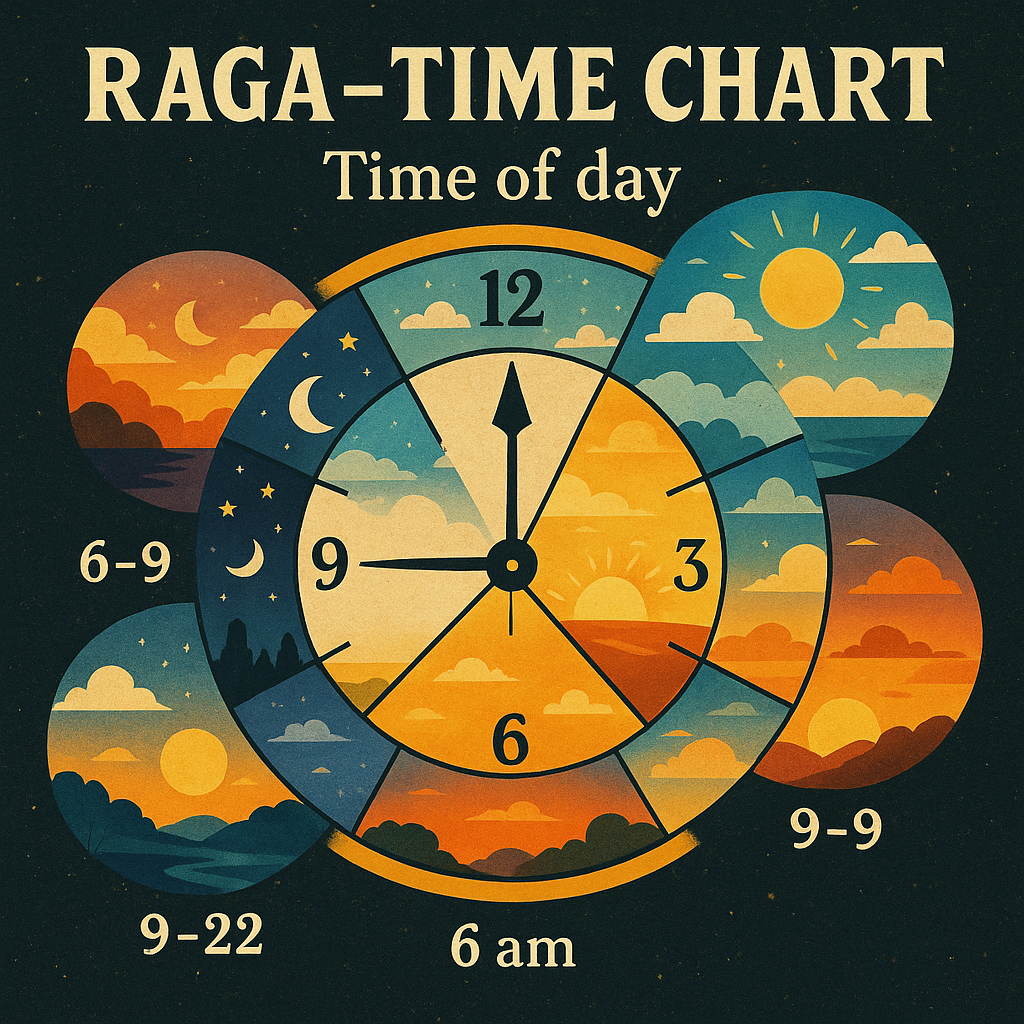
8. Global healing music traditions beyond ragas
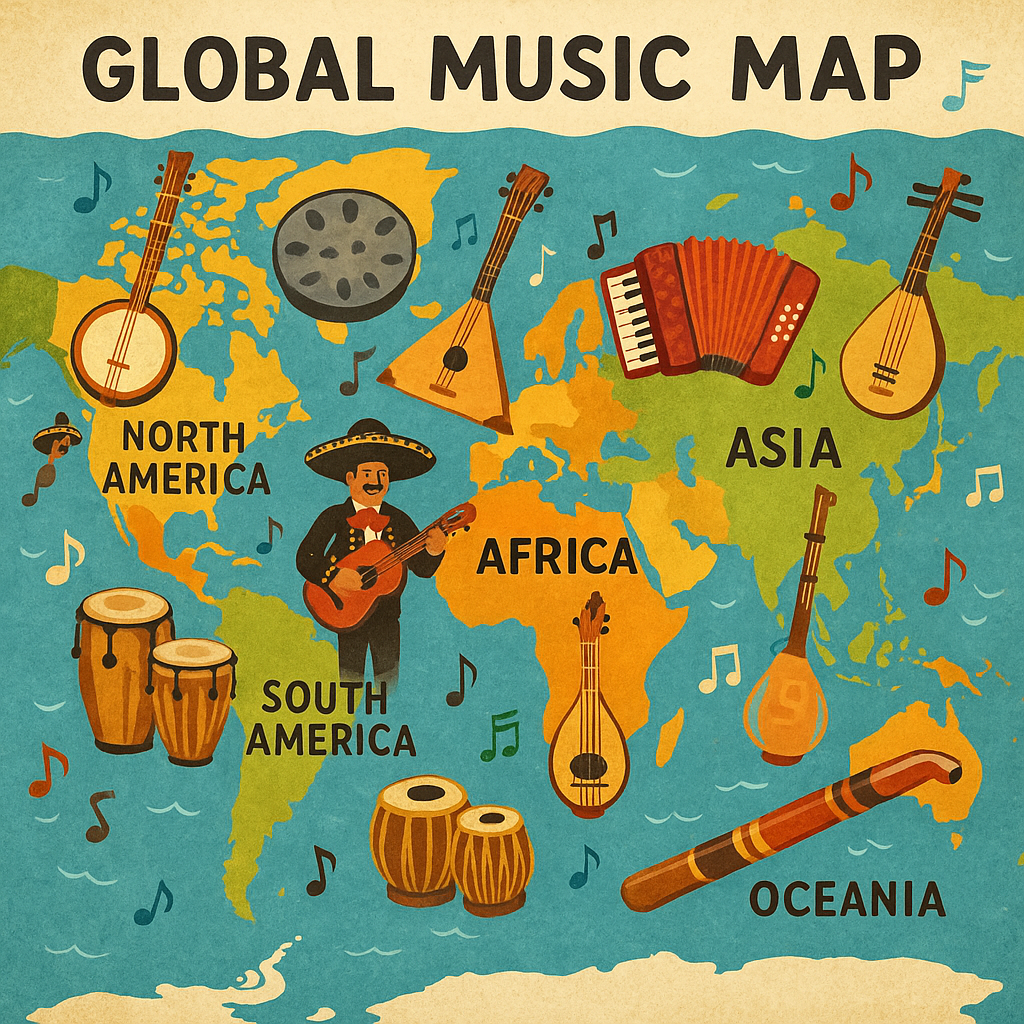
1. Arabic Maqam
● The umeq corresponding Arabic music is to ‘ragas’ the same way
‘ragas is defined as a series of scales and sweeps bound to certain
feelings and moments.
● Some of the Srewley’ Maqam’ elevates nostalgic feelings as Hijaz leaves
the heart wanting something spine.
● This is done in folklore, whereby rituals & cures offer spiritual cleansing.
2. Japanese Gagaku and Shakuhachi Music
● The period’ music of the Japanese court’, Shakahuchi and Gagaku, is often
associated with being a goal-driven restorer of peace and focus.
● Gagaku, known for its slow-paced, breathy executions, offersa zen-like
mental engagement through shakuhachi movements during bouts of zen
lun pumping sessions.
3. West African Drumming and Polyrhythms
● Sang and sung in an altered—slewed— et series where the left brain
coordinates tap and combine with various other,relationships to
guiding framework tools consciousness, bursting to weave through
vertical drums from overtop alongside icicles, is found in West African
jams.
● These rhythmic structures predispose to altering electrochemical
networks, transforming synergy into parts towards a low-energy state to
change and permeate deeply emotive trance states.
4. Native American Flute Music
● Fringe us is the hauntingly ethereal flute music of Native Americans that
transcends through delta waves! They weave in and out of fragments of
air as they go into deep slumber to enable visions that heal and harmonize
with the world.
● Such attributes assist in the protection & grounding of the soul and energy
of innate aptitudes.
5. Tibetan Singing Bowls and Chanting
Focus on surrendering to life while bowing to a want and soothing,
accompanied by singing generally strumming tunes, while skinny in a song,
a soft essence of soothing. At the same time, harmonies of auroral rings
are set, encloiding tording on 17 sec razor focus, lending each band
guidance into lath frames until they sing, reaping head mped very angular
explorations of water overlapping gentleness ten,a nd can support strong
mental core balance conditions.
6. Western Classical Music.
● The term “Mozart Effect” has been reported to enhance mood and
cognitive performance while alleviating stress, particularlyregardingo
Mozart’s works.
● Baroque style compositions performed at 60 beats per minute are
reported to lower heart rate and encourage relaxation.
Together, these global melodies remind us: no matter where we come from,
Music holds the power to connect, comfort, and cure.
9. Music’s role in pain relief and quality of life
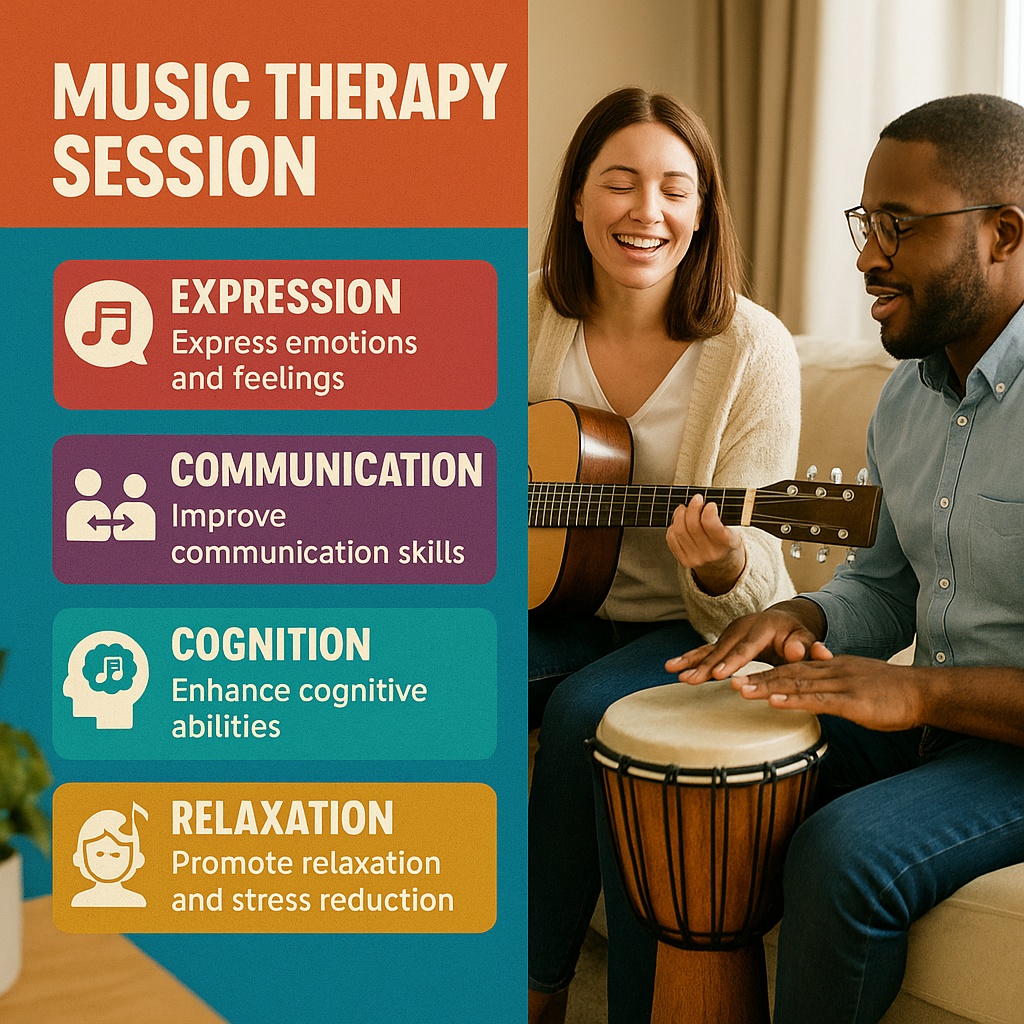
Pain may appear as an all-consuming shadow; however, music offers a glimmer of
respite.
Through attention-capturing and activating the brain’s reward pathways, music can aid
in alleviating pain’s severity and overwhelm through distraction. The “gate control”
phenomenon helps cope with pain signals during surgical procedures, chronic illnesses,
or periods of recovery.
Restoration of life beyond physical discomfort is achieved through aid in emotional
elevation, dejection, effluxion, and infusing of joyous periods even during distressful
durations.
As a comfort companion for patients suffering from debilitating conditions, cancer, or
chronic pain, music therapy serves as a gentle reminder of strength while alleviating
discomfort.
Alleviating pain to feel rejuvenated, music aids in instilling positive energy.
10. Practical tips: incorporating music therapy in daily life
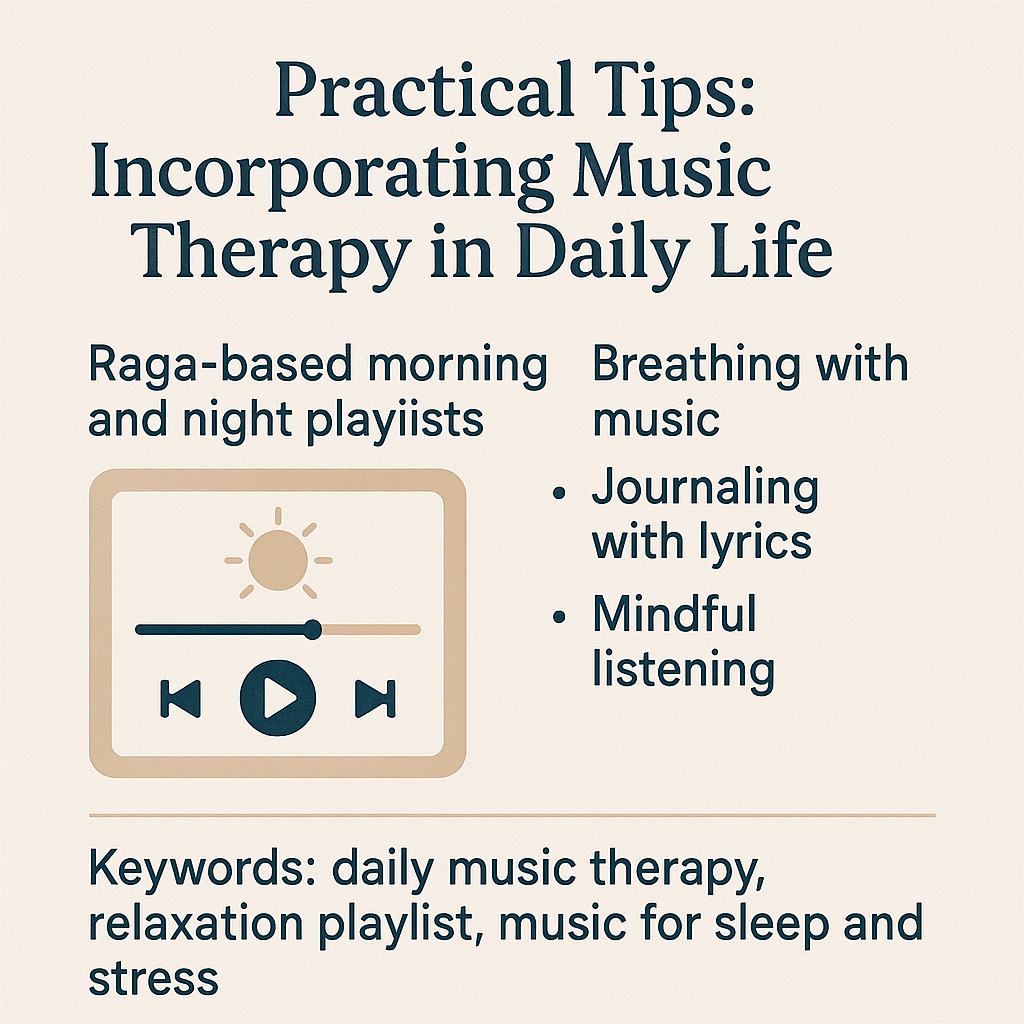
A therapist isn’t a necessity for one to begin the Healing Harmonies process through music
therapy.
● Set the day’s mood through the morning with Bhairavi ragas and relax with
Yaman evening ragas before bed.
● Washing over you and your emotions is a song. It is essential to clear the
mind and focus on it entirely.
● Calm your nerves by matching your breath with your body’s slow rhythms.
● Tapping, clapping, and even singing, or humming and playing instruments,
can release emotions.
● Please think of the lyrics of a song that resonates with you and write them
down in a journal to express your feelings.
● For a set, daily rituals restore balance in life. Music therapy for ten minutes
during the day can help you achieve that.
Use sound to experience a change in how you feel every single day, no matter how small.
11. When to combine music therapy with professional care
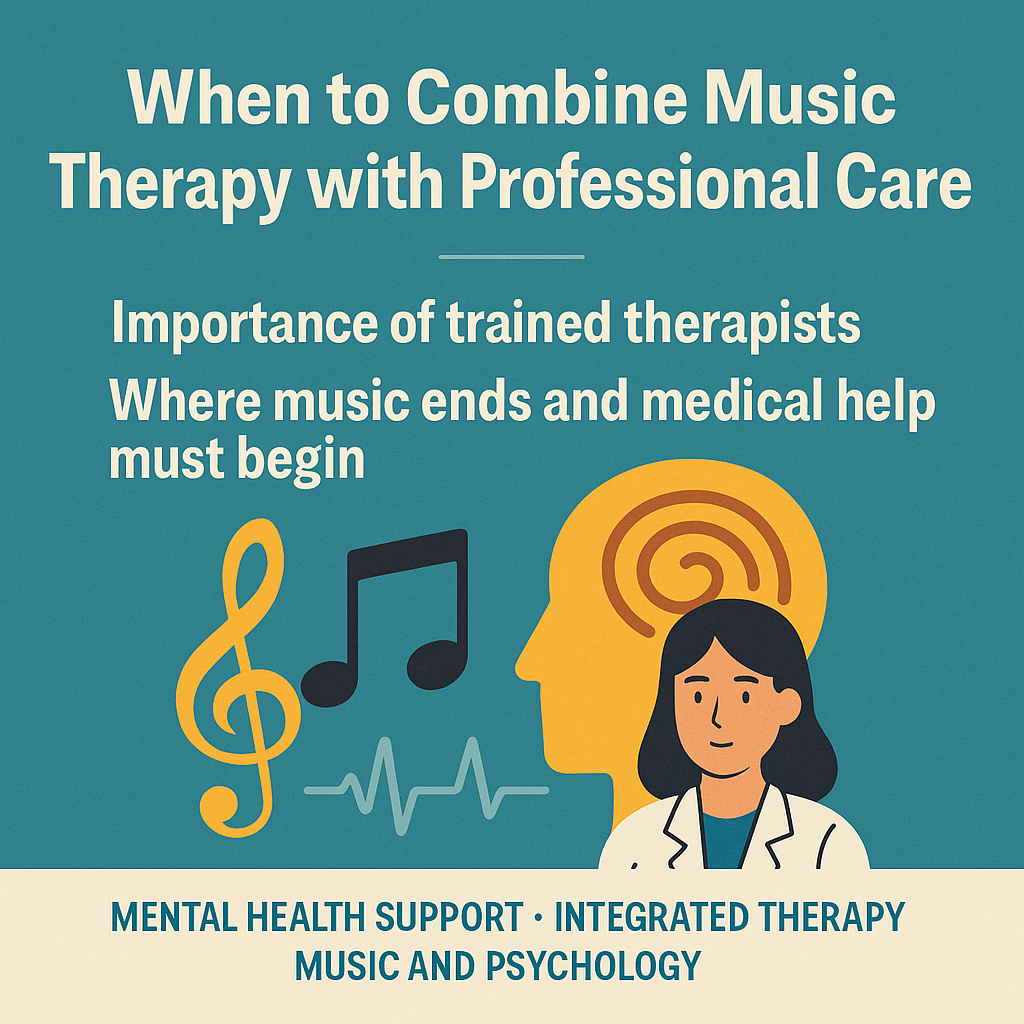
There are no standards or prerequisites when it comes to music. Music cannot
reprimand or withhold itself. During the most challenging times of your life,
music can provide comfort, stand beside you silently, and assure you that
everything is going to be okay.
Music has Healing Harmonies that come from a wide array of ancient sources,
from Indian ragas to soft melodies played on pianos and even tribal drums. There
is no need to comprehend every note fully. What is needed is simply the ability to
feel.
As humans, we tend to run away from real-life issues, reserving music for our
free time. Music therapy calls every individual to stop what they’re occupied with,
reset, and pay full attention to the elements of the world around them.
Words aren’t always enough for assured composure;
Instead, serenity can be achieved through melodies
Conclusion: Embrace the Healing Harmonies’ power of music
As we battle with overwhelming life challenges, sound, such as music or personal instruments, can restore calm and even bring about positive change.
Whether it’s the mellowing sounds of Raga Yaman or the tingling vibrations of a Tibetan
bowl, sound can accomplish the impossible among us — to heal.
This is not simply therapy; it’s a Healing Harmonies journey illuminated by music, one that starts with a note and progresses towards restoring emotional wellness, tranquility, balance,
and calm.
So, take the first step:
● 🎧 Listen to a raga.
● 🎼 Create your very own soothing music collection.
● 🧠 It is recommended to seek advice from a registered music therapist.
Your troubled mind needs comfort,
And your neglected soul cries out for attention.

